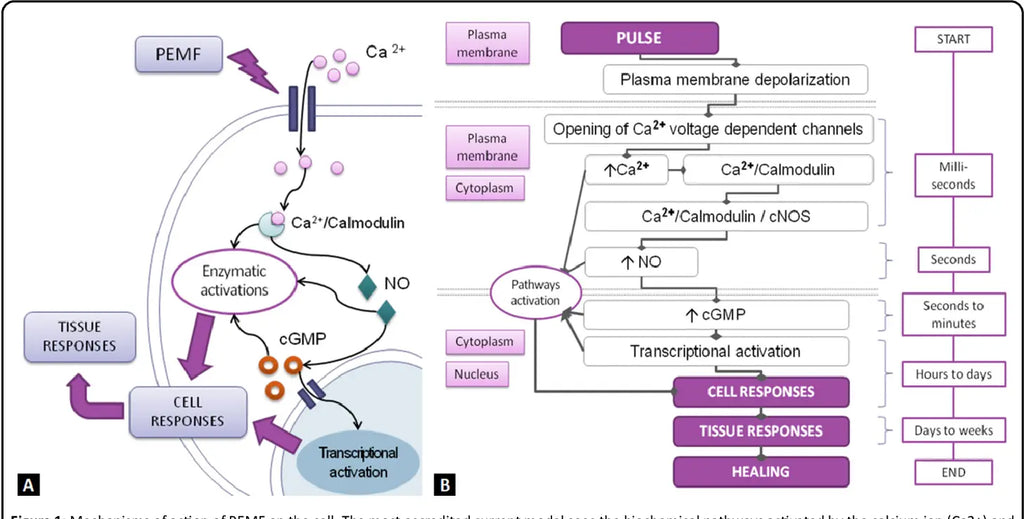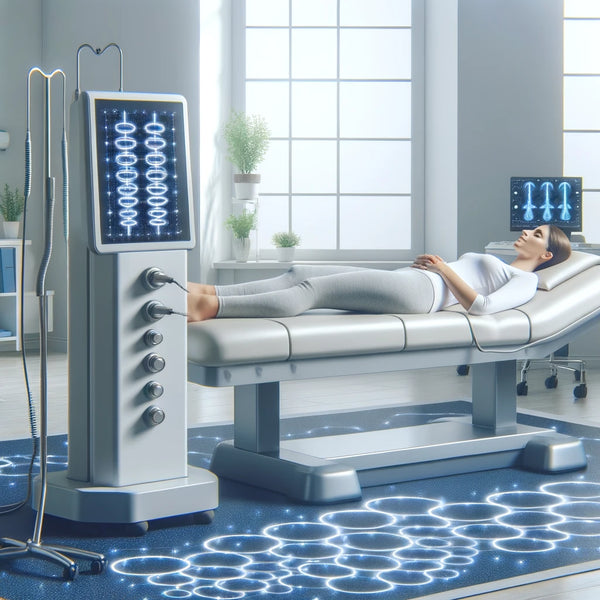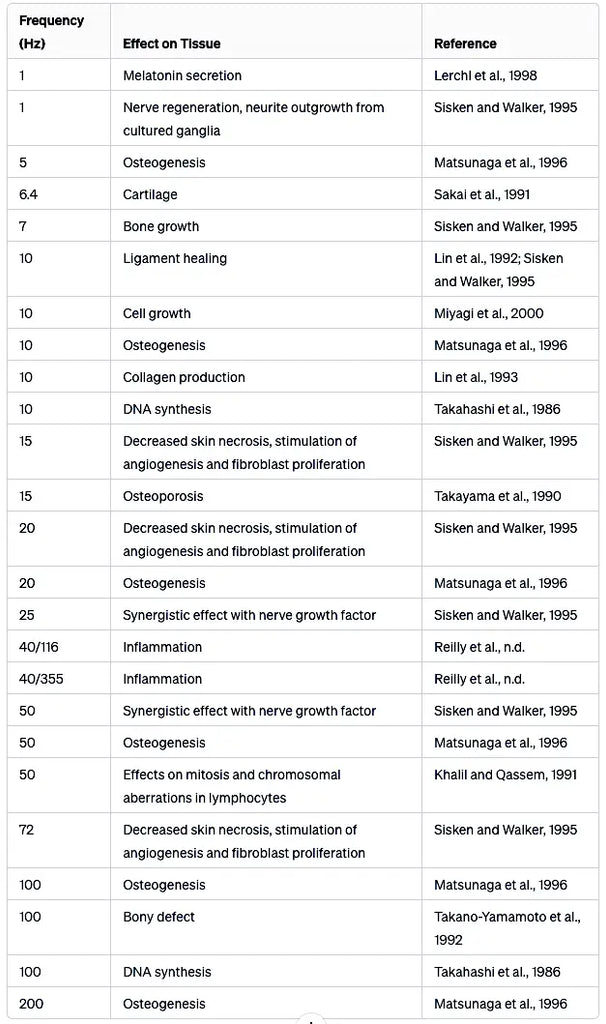Терапия PEMF (импульсное электромагнитное поле) привлекает внимание в обществе здравоохранения за его неинвазивный подход к решению различных проблем со здоровьем. Эта статья предлагает подробный взгляд на терапию PEMF, объясняя, как она работает, ее преимущества и ее применение в современной медицине. Это руководство, идеально подходящее для медицинских работников и отдельных лиц, ищущих альтернативные методы лечения, дает четкую информацию о терапии PEMF, поддерживаемой научными исследованиями и опытом пациента. Узнайте, как это инновационное лечение может способствовать улучшению здоровья и благополучия.
Пульсирующее электромагнитное излучение предназначено для того, чтобы оказывать специфическое физиологическое воздействие на желаемую область тела. Еще в 1950 -х годах было обнаружено, что электрический потенциал влияет на рост костей. В 1974 году были опубликованы положительные исследования о влиянии импульсной магнитной терапии на заживление переломов и различных тканей.(1-2) С тех пор несколько сотен исследований терапии PEMF были опубликованы у животных и людей.
Механизмы действия
Терапия импульсным электромагнитным полем (PEMF) сложна и включает в себя множество природных клеточных процессов. Терапия PEMF работает, вызывая электрические изменения в клетках и их окружении. Это делается путем рассылки электромагнитных полей. Эти поля меняются в том, как часто они случаются, их сила и как долго они длится. Все зависит от того, какое использование или цель терапия имеет для них.(3)
Наиболее аккредитованная модель тока видит биохимические пути, активируемые ионом кальция (CA2+), а затем с помощью азотного кислорода (NO) и CGMP в качестве ключевых механизмов действия PEMF на клеточном уровне и, следовательно, на ответы тканей Полем(4)

Изображение: Механизмы действия PEMF на клетку.
Источник: Luigi, C. & Tiziano, P. (2020). Механизмы действия и эффекты импульсных электромагнитных полей (PEMF) в медицине. Журнал медицинских исследований и хирургии 1 (6): 1-4.
Индукция электрических изменений
Каждая ячейка в организме имеет электрический заряд, что имеет решающее значение для поддержания ее нормальной функции. Терапия PEMF влияет на эти заряды, вызывая электрические изменения в клетках. Эта электромагнитная индукция стимулирует клетки и перезаряжает их мембраны, тем самым усиливая их общую функциональность.
Стимуляция клеточного метаболизма
Импульсные электромагнитные поля (PEMF) показывают потенциальное влияние на определенные типы клеток человека, причем более высокие частоты, плотность потока и хроническое воздействие более эффективно при установлении клеточного ответа, ведущего к клеточному «перезарядке». Это усиление производства энергии имеет решающее значение для поддержания эффективного клеточного метаболизма. Повышенная клеточная энергия приводит к более высокой функциональности, от восстановления клеток и регенерации до более эффективной клеточной передачи сигналов.(5)
Усиление кровообращения
Электромагнитные поля, полученные с помощью терапии PEMF, значительно влияют на кровеносные сосуды. Они стимулируют расширение кровеносных сосудов, тем самым увеличивая кровоток. Усиленная циркуляция гарантирует, что больше кислорода и питательных веществ доставляется в ткани, а также помогает удалить отходы. Этот процесс жизненно важен для заживления и поддержания здоровых тканей. Терапия PEMF может также улучшить артериальное давление из -за его сосудистых эффектов.(6)
Продвижение регенерации тканей
Лечение PEMF помогает ускорить заживление и рост различных частей тела, включая кости, мышечные и нервные клетки. PEMF запускает различные клеточные пути, которые поддерживают рост и специализацию клеток.(7) Электромагнитные поля усиливают выработку белков и других важных компонентов, необходимых для восстановления тканей, что делает его ценным инструментом для восстановления после травм и операций.
Модуляция клеточной связи
Терапия также влияет на то, как клетки общаются друг с другом. Клетки общаются через электрические и химические сигналы; Терапия PEMF может усилить эти сигнальные пути. Улучшенная клеточная связь приводит к более скоординированной функции ткани и органов, необходимых для поддержания гомеостаза и общего состояния здоровья.
Влияние на ионные каналы и клеточные мембраны
Обработка PEMF меняет, как легко вещества могут проходить через клеточные стенки. Управление ионными путями на поверхности клетки позволяет ионам кальция, натрия и калия вводить и выходить из клетки.(8) Этот ионный обмен очень важен для различных функций в ячейках. К ним относятся сокращение мышц, нервную передачу сигналов и контроль циклов роста клеток.

За последние два десятилетия были разработаны системы PEMF всего тела, которые могут улучшить, например, микроциркуляция и метаболизм. (9) Также было обнаружено, что устройства ускоряют восстановление различных тканей и помогают облегчить боль. Согласно мета-анализу, опубликованному в 2009 году, PEMFT может облегчить боль и улучшить функционирование у людей с остеоартритом колена.(10) Некоторые люди также используют устройства в качестве форм терапии стресса.
Терапия PEMF может ускорить восстановление после физических упражнений и, среди прочего, увеличить функцию блуждающего нерва и увеличить изменчивость сердечного ритма (HRV).(11) Согласно 4-летнему исследованию, опубликованному NASA, терапия PEMF полезно при регенерирующих стволовых клетках нервной системы.(12) Префронтальная транскраниальная магнитная стимуляция (TMS) может помочь лечить депрессию.(13)
Специфичные для мозга преимущества терапии PEMF
Одна из критических областей, где терапия PEMF демонстрирует потенциал в здоровье головного мозга и нервной системы, заключается в неврологическом выздоровлении, особенно после травматических травм головного мозга и инсультов. Терапия помогает восстановить поврежденные нейронные ткани, тем самым усиливая функциональное восстановление. Этот аспект имеет решающее значение для пациентов, занимающихся долгосрочными эффектами неврологических травм.(14-15)

Терапия PEMF также была исследована за ее роль в лечении боли, особенно для таких состояний, как хронические мигрени и головные боли напряжения. Изменив болеутоляющие сигналы в мозге и обращаясь к лечению лежащего в основе воспаления, PEMF может предложить неинвазивный вариант для облегчения боли.(16-17) Кроме того, существуют признаки того, что терапия PEMF может положительно влиять на когнитивные функции, включая память и концентрацию, путем повышения нейронной эффективности и модуляции мозговых волн.(18) Положительные когнитивные эффекты особенно актуальны для стареющих популяций и тех, кто подвергается риску снижения когнитивных средств.
Частоты и функции мозговых волн:
- Дельта волны - (0,1 - 4 Гц) (сон)
- Тета -волны - (4 - 7 Гц) (обучение и медитативное состояние)
- Альфа -волны - (8 - 15 Гц) (привычная деятельность и расслабление; эти уменьшаются, если наблюдается что -то необычное)
- «Му» волны - (7,5 - 12,5 Гц) (ритм, который поддерживает другие функции)
- SMR волны - (12,5 - 15,5 Гц) (ритм, который поддерживает другие функции)
- Бета -волны - (16 - 31 Гц) (когнитивная деятельность и умственная деятельность).
- Гамма -волны - (32 - 140 Гц) (работа, активная работа)
Терапия PEMF также может помочь в регуляции настроения и психическом здоровье. Исследования показывают его потенциал для улучшения таких состояний, как депрессия и тревога, возможно, влияя на уровни нейротрансмиттеров и нервные пути.(19-20) Терапия PEMF может повысить качество сна, способствуя расслаблению и положительно влиять на модели мозговых волн, принося пользу людям с бессонницей или нарушениями сна.(21)
Интересно, что потенциал терапии PEMF для повышения нейропластичности - способность мозга формировать новые нейронные связи - является перспективным для улучшения обучения и восстановления после травм головного мозга.(22-24) Кроме того, его влияние на снижение воспаления головного мозга и стресса делает его захватывающим вариантом для целостного подхода к здоровью мозга.(25)
Для терапии мозга PEMF мы рекомендуем передовые и научно подтвержденные NEORHYTHM OMNIPEMF Устройство. Neorhythm предлагает единственную неинвазивную технологию, которая позволяет вам выбрать ваше состояние ума. Разработанный, чтобы помочь вам успокоиться, лучше спать, расслабиться, снять стресс, увеличить фокус и многое другое.
PEMF Therapy's Влияние на различные системы органов
- Скелетно -мышечная система: Терапия PEMF эффективна в заживлении костей и мышечных проблемах, таких как остеоартрит и переломы. Это укрепляет кости и помогает им быстрее исцелиться, наряду с мягкими частями тела.(26)
- Нервная система: Исследования показывают, что PEMFT оказывает положительное влияние на нейропластичность, помогая выздоровлять травматические повреждения головного мозга и инсульты. Кроме того, это помогает в управлении хронической болью и невропатическими состояниями.
- Сердечно -сосудистая система: Это помогает улучшить кровоток, уменьшить отек и улучшить часть тела, которая выстраивает наши кровеносные сосуды. Это может быть полезно для решения проблем со здоровьем, такими как высокое кровяное давление и проблемы в небольших артериях, далеко от нашего сердца.
- Иммунная система: Лечение PEMF может изменить иммунную реакцию организма, что может помочь при заболеваниях, вызванных проблемами иммунной системы и усилить общую иммунную защиту.(27)
- Желудочно -кишечная система: Ранние исследования показывают, что PEMF может помочь уменьшить признаки и симптомы синдрома раздраженного кишечника (СРК).(28)
PEMF Therapy использует низкочастотную (0–40 Гц) и низкоинтенсивную (10–200 мг) излучение, которое очень близко к уровню вибрации земли 3–60 Гц (так называемый резонанс Schumann).(29-30) Различные частоты могут стимулировать различные ткани для достижения желаемого воздействия на здоровье (см. Таблицу ниже).(31) Наиболее часто используемая частота составляет 10 Гц. Точно так же многие потенциально вредные технологические устройства используют значительно более высокие частоты, такие как смартфоны (450-2700 МГц) и беспроводные базовые станции (2,4-5,9 ГГц).(32-33)

Изображение: Влияние различных частот на уровне ткани.
Источник: Oschman, J. (2016). Энергетическая медицина: научная основа (2 -е издание). Лондон: Elsevier »для первоначального контекста и научной точности.
Заключение
Терапия PEMF (импульсное электромагнитное поле) значительно продвигает медицинское и самостоятельное лечение, предлагая широкие терапевтические преимущества в различных системах органов. Его неинвазивная природа и эффективность в улучшении клеточной функции и содействии исцелению делают его практическим и эффективным инструментом в профилактическом и интегрированном здравоохранении. Хотя он показывает перспективы в лечении боли, заживлении костей и восстановлении нервной системы, его полный потенциал все еще изучается. Постоянные исследования необходимы для дальнейшего понимания своих возможностей и расширения своих медицинских применений. Поскольку исследования продолжаются, терапия PEMF обладает потенциалом для революции аспектов ухода за пациентами и благополучия, демонстрируя уникальную смесь безопасности и эффективности при лечении, аналогичных другим неинвазивным методам лечения, такими как фотобиомодуляция и легкая терапия.
Научные ссылки:
- Bassett, C. & Pawluk, R. & Pilla, A. (1974). Ускорение ремонта переломов электромагнитные поля. Хирургически неинвазивный метод. Анналы нью -йоркской академии наук 238: 242–262.
- Bassett, C. & Pawluk, R. & Pilla, A. (1974). Увеличение восстановления костей индуктивно связанные электромагнитные поля. Наука 184 (4136): 575–577.
- Flatscher, J., Pavez Loriè, E., Mittermayr, R., Meznik, P., Slezak, P., Redl, H. & Slezak, C. (2023). Импульсные электромагнитные поля (PEMF) - Физиологический ответ и его потенциал при лечении травмы. Международный журнал молекулярных наук, 24(14), 11239.
- Luigi, C. & Tiziano, P. (2020). Механизмы действия и эффекты импульсных электромагнитных полей (PEMF) в медицине. Журнал медицинских исследований и хирургии 1 (6): 1-4.
- Mansourian, M. & Shanei, A. (2021). Оценка эффектов импульсного электромагнитного поля: систематический обзор и метаанализ на основных моментах двух десятилетий исследований in vitro. Biomed Research International 6647497.
- Стюарт, Г. М., Уитли -Гуй, С. М., Джонсон, Б. Д., Шен, В. К. и Ким, С. Х. (2020). Влияние импульсной электромагнитной поля терапии на сосудистую функцию и артериальное давление у индивидуумов с гипертонией. Журнал клинической гипертонии, 22(6), 1083-1089.
- Schnoke, M. & Midura, R.J. (2007). Импульсные электромагнитные поля быстро модулируют внутриклеточные сигнальные события в остеобластических клетках: сравнение с гормоном околощитовидной железы и инсулином. Журнал ортопедических исследований, 25(7), 933-940.
- Petecchia, L. et al. (2015). Электромагнитное поле способствует остеогенной дифференцировке BM-HMSC с помощью селективного действия на механизмы, связанные с CA2+. Научные отчеты, 5(1), 13856.
- Klopp, R. & Niemer, W. & Schmidt, W. (2013). Влияние различных методов физического лечения о артериолярных вазомоциях и микрогемодинамических функциональных характеристиках в случае дефицитной регуляции кровотока органов. Результаты плацебо-контролируемого, двойное слепое исследование. Журнал дополнительной и интегративной медицины 10 (Suppl): S39–46.
- Vavken, P. & Arrich, F. & Schuhfried, O. & Dorotka, R. (2009). Эффективность импульсной электромагнитной поля терапии при лечении остеоартрита колена: метаанализ рандомизированных контролируемых исследований. Журнал реабилитационной медицины 41 (6): 406–411.
- Grote, V. et al. (2007). Краткосрочные эффекты импульсных электромагнитных полей после физических упражнений зависят от вегетативного тонуса перед воздействием. Европейский журнал прикладной физиологии 101 (4): 495–502.
- Гудвин Т. (2003). Физиологические и молекулярные генетические эффекты изменяющихся во времени электромагнитных полей на нейрональных клетках человека. НАСА/TP-2003-212054.
- Perera, T. et al. (2016). Клиническое обзор консенсуса Общества ТМС и рекомендации по лечению терапии ТМС при крупном депрессивном расстройстве. Стимуляция мозга 9 (3): 336–346. Обзор.
- Capone, F. et al. (2022). Импульсные электромагнитные поля: новая привлекательная терапевтическая возможность для нейропротекции после острой церебральной ишемии. Нейромодуляция: технология на нейронном графике, 25(8), 1240-1247.
- Bragin, D.E., Statom, G.L., Hagberg, S. & Nemoto, E.M. (2015). Увеличение микрососудистой перфузии и оксигенации тканей посредством импульсных электромагнитных полей в здоровом мозге крысы. Журнал нейрохирургии, 122(5), 1239-1247.
- Feng, Y., Zhang, B., Zhang, J. & Yin, Y. (2019). Влияние неинвазивной стимуляции мозга на интенсивность головной боли и частоту приступов головной боли у пациентов с мигрени: систематический обзор и метаанализ. Головная боль: журнал боли головы и лица, 59(9), 1436-1447.
- Thomas, A.W., Graham, K., Prato, F.S., McKay, J., Forster, P.M., Moulin, D.E. & Chari, S. (2007). Рандомизированное, двойное слепое плацебо-контролируемое клиническое исследование с использованием низкочастотного магнитного поля при лечении хронической боли в опорно-двигательном скелете. Исследование боли и управление, 12, 249-258.
- Drumond Marra, H.L., Myczkowski, M.L., Maia Memória, C., Arnaut, D., Leite Ribeiro, P., Sardinha Mansur, C.G., ... & Marcolin, M.A. (2015). Транскраниальная магнитная стимуляция для устранения легких когнитивных нарушений у пожилых людей: рандомизированное контролируемое исследование. Поведенческая неврология, 2015.
- Karabanov, A.N. & Siebner, H.R. (2014). Расширение электротерапевтического инструментария: перспектива транскраниальных пульсирующих электромагнитных полей (T-PEMF). Acta Necropsychiatrica, 26(5), 261-263.
- Peng, Z., Zhou, C., Xue, S., Bai, J., Yu, S. & Li, X. Механизм повторяющейся транскраниальной магнитной стимуляции для депрессии. Шанхайская арха психиатрия. 2018; 30 (2): 84–92.
- Nardone, R., Sebastianelli, L., Versace, V., Brigo, F., Golaszewski, S., Pucks-Faes, E., ... & Trinka, E. (2020). Влияние повторяющейся транскраниальной магнитной стимуляции у субъектов с расстройствами сна. Медицина сна, 71, 113-121.
- Халлетт, М. (2007). Транскраниальная магнитная стимуляция: праймер. Нейрон 55 (2): 187–199.
- Jannati, A. & Oberman, L. & Rotenberg, A. & Pascual-Leone, A. (2023). Оценка механизмов пластичности мозга с помощью транскраниальной магнитной стимуляции. Нейропсихофармакология 48 (1): 191–208.
- Auriat, A. & Neva, J. & Peters, S. & Ferris, J. & Boyd, L. (2015). Обзор транскраниальной магнитной стимуляции и мультимодальной нейровизуализации для характеристики нейропластичности после инсульта. Границы в неврологии 6: 226.
- Vincenzi, F., Ravani, A., Pasquini, S., Merighi S., Gessi S., Setti S., ... & Varani, K. (2017). Импульсное воздействие электромагнитного поля уменьшает гипоксию и повреждение воспаления в нейроноподобных и микроглиальных клетках. Журнал клеточной физиологии, 232(5), 1200-1208.
- Tong, J., Chen, Z., Sun, G., Zhou, J., Zeng, Y., Zhong, P., ... & Liao, Y. (2022). Эффективность импульсных электромагнитных полей на боль, жесткости и физической функции при остеоартрите: систематический обзор и метаанализ. Исследование боли и управление, 2022.
- Ross, C.L., Zhou, Y., McCall, C.E., Soker, S. & Criswell, T.L. (2019). Использование импульсного электромагнитного поля для модуляции воспаления и улучшения регенерации тканей: обзор. Биоэлектричество, 1(4), 247-259.
- Греч, А.Дж. (2021). Использование импульсных электромагнитных полей (PEMF) с низкой интенсивностью для уменьшения признаков и симптомов синдрома раздраженного кишечника (СРК): небольшое рандомизированное, одно слепое контролируемое исследование (Докторская диссертация, Университет Сайбрука).
- Muehsam, D. & Ventura, C. (2014). Жизненный ритм как симфония колебательных паттернов: электромагнитная энергия и звуковая вибрация модулирует экспрессию генов для биологической передачи сигналов и заживления. Глобальные достижения в области здравоохранения и медицины 3 (2): 40–55.
- Mitsutake, G. et al. (2005). Влияет ли резонанс Шумана на наше артериальное давление?Биомедицина и фармакотерапия = биомедицина и фармакотерапия 59 (Suppl 1): S10 - S14.
- Oschman, J. (2016). Энергетическая медицина: научная основа (2 -е издание). Лондон: Elsevier.
- Prasad, M. & Kathuria, P. & Nair, P. & Kumar, A. & Prasad, K. (2017). Использование мобильного телефона и риск Опухоли головного мозга: систематический обзор связи между качеством исследования, источником финансирования и результатов исследований. Неврологические науки 38 (5): 797–810.
- Марков, М. и Григорьев, Ю. (2013). Технология Wi-Fi-неконтролируемый глобальный эксперимент на Здоровье человечества. Электромагнитная биология и медицина 32 (2): 200–208.






